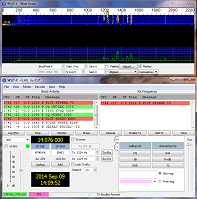
E' uscita la versione DEFINITIVA di WSJT-X v. 2.7.0
Note di release:
Rilascio: WSJT-X 2.7.0
17 febbraio 2025
WSJT-X 2.7.0 è un rilascio di General Availability (GA), il primo dopo
versione 2.6.1. I miglioramenti principali includono un nuovo programma di accompagnamento QMAP, nuove attività operative speciali "Q65 Pileup" e "SuperFox", una nuova funzione "Sistema di messaggi", un'opzione per aggiornare Hamlib con un clic su un pulsante e vari altri miglioramenti.
- QMAP è di particolare interesse per coloro che sono impegnati nella comunicazione Terra-Luna-Terra (EME). Fornisce capacità di solo ricezione a polarizzazione singola per uno dei sottomodi di 60 secondi del Q65 e il sottomodo di 30 secondi associato con la stessa spaziatura tono. Ti permette di monitorare tutto il traffico corrispondente in una sottobanda di 90 kHz mentre conduci QSO EME nel solito modo con WSJT-X.
- La modalità Pileup Q65 aiuta gli operatori DX che utilizzano Q65 in circostanze con molti chiamanti simultanei e segnali molto deboli, come quelli sperimentati da 6 metri EME DXpeditions.
- La modalità SuperFox si comporta in modo operativo come il vecchio stile Fox and Hounds ma usa una nuova forma d'onda costante per le trasmissioni Fox.
I messaggi possono essere trasmessi simultaneamente a ben 9 Hounds senza penalità di forza del segnale, con un guadagno di sistema di circa +10 dB rispetto alla vecchia operazione Fox-and-Hound utilizzando 5 slot. - Il nuovo sistema di messaggi consente di inviare messaggi di testo semplici strutturati al tuo partner QSO per richiedere QSY ad un'altra banda o modalità, o per inviare uno qualsiasi dei numerosi messaggi in scatola. Questa funzione può essere particolarmente utile durante i concorsi.
- Un pulsante chiamato "Update Hamlib" ti permette di scaricare e installare l'ultima versione delle funzionalità di controllo rig in Hamlib.
- La Cty. questo file può essere aggiornato facendo clic su un singolo pulsante.
Numerosi altri miglioramenti e correzioni di bug rendono l'operazione più fluida e intuitiva. Le funzionalità per il passaggio della finestra principale da una modalità all'altra sono state migliorate in modo che la sottomodalità e lo stato delle caselle Sh e Fast siano salvati e ripristinati dalla modalità. Notare che la funzione "Aggiornamento Hamlib" è attualmente disponibile solo su Windows.
